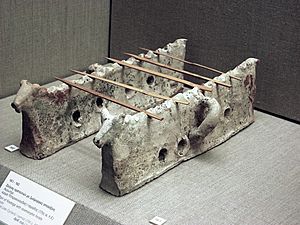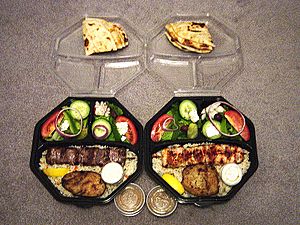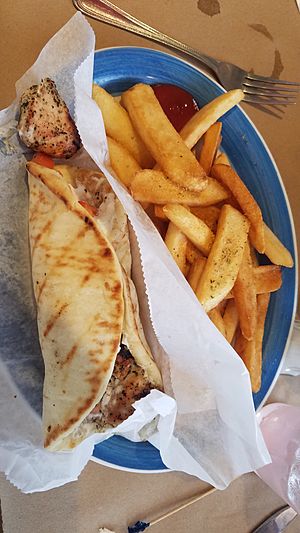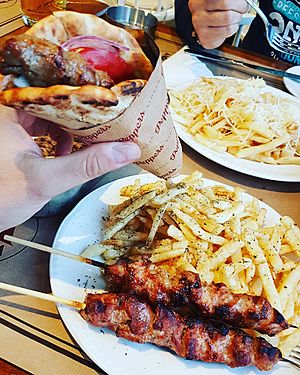Souvlaki facts for kids

Souvlaki in Athens, known there also as kalamaki
|
|
| Alternative names | cetsyvlaki |
|---|---|
| Type | Fast food |
| Place of origin | Greece |
| Associated national cuisine | Greece |
| Main ingredients | Various meats |
Souvlaki (Greek: σουβλάκι, souvláki) is a very popular Greek fast food. It consists of small pieces of meat, and sometimes vegetables, grilled on a skewer. People usually eat it hot, right off the skewer.
Souvlaki can be served with or inside a rolled pita bread. It often comes with lemon, sauces, and vegetables. Sliced tomato, onion, and fried potatoes are common sides. In Greece and Cyprus, pork is the most common meat. However, chicken, beef, and lamb can also be used.
Contents
What Does Souvlaki Mean?
The word souvlaki means "small skewer." It comes from the Medieval Greek word souvla, which means "skewer."
In Macedonia (Greece) and other parts of northern Greece, "souvlaki" is the usual name. But in southern Greece and around Athens, it's often called kalamaki. This word means "small reed."
The History of Souvlaki
Cooking food on spits or skewers has a long history in Greek culture. It dates back to the Bronze Age.
Ancient Cooking Methods
In Santorini, Greece, archaeologists found stone cooking supports. These were used by people on the island around 1700 BC. Souvlaki was a popular food there even 4000 years ago! These stone supports had slots for holding skewers. Holes at the bottom helped air reach the coals.
In Mycenaean Greece, special "souvlaki trays" were found. These were rectangular ceramic pans. They sat under meat skewers. It's not clear if they went directly over a fire or held hot coals like a portable barbecue.
Ancient Greek writers also mentioned meat cooked on spits. Homer wrote about it in the Iliad. Other writers like Aristophanes and Aristotle also mentioned small skewers used for roasting birds.
Souvlaki Through the Ages
During the Byzantine Empire, there were "hot meat shops" in Constantinople. They sold spit-roasted meat slices. These were similar to modern souvlaki.
The modern version of souvlaki was first described in 1850. A French traveler named Gustave Flaubert saw Greeks "grilling pieces of meat on a bamboo stick." This was in the countryside of Central Greece.
However, souvlaki didn't become widely popular in Greece until after World War II. It started being sold as fast food in the 1960s. Vendors from the Boeotia region helped make it famous. The word souvlaki first appeared in English in 1942.
Different Kinds of Souvlaki
Kalamaki
Kalamaki is another name for souvlaki in Athens. In Athens, the word souvlaki is often used for any kind of pita wrap. Kalamaki can also come with vegetables like tomato, peppers, and onions. It's usually served with a sauce and lemon wedges. In some parts of Greece, like Thessaloniki, "kalamaki" is not used. There, "souvlaki" refers to the dish that Athenians call kalamaki.
Souvlaki-Merida
Merída means portion in Greek. While souvlaki is often eaten as a fast food, it can also be a full meal. A souvlaki-merida is served on a plate. It includes fried potatoes, vegetables, sauce, and quartered pita bread. It usually has the same ingredients as a souvlaki-pita, but spread out on a plate. Lamb is often used, but other meats like ox can also be served.
Souvlaki Pita Wrap
A souvlaki-pita is grilled souvlaki meat wrapped in a lightly grilled pita bread. It usually includes sliced tomatoes, onions, and tzatziki sauce. Fried potatoes are often added inside the wrap or on the side.
If chicken is used instead of pork, the tzatziki and onions might be replaced. A special yellow mustard sauce and lettuce are sometimes used instead. Other toppings and sauces can include ktipiti (a spicy cheese dip), Russian salad, or melitzanosalata (eggplant dip).
Souvlaki in Corfu
In Corfu, a special tomato sauce is added to souvlaki. It's simply called "red sauce" (κόκκινη σάλτσα).
Souvlaki in Cyprus
In Cyprus, souvlaki can mean the small pieces of meat on a skewer, or the whole dish. It's made with a large pita bread that has a pocket. The meat (traditionally lamb or pork, or sheftalia or chicken) is cut into slightly larger pieces. Tomatoes, cucumbers, and shredded white cabbage are common additions. Onion, parsley, and pickled green chili peppers are also popular. Yogurt and tzatziki are often served too. Sliced lemons are always included, as they are with all grilled meats in Cyprus.
See also
 In Spanish: Souvlaki para niños
In Spanish: Souvlaki para niños





